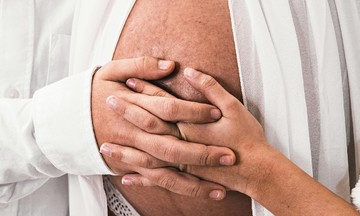An ultrasound at Tam Anh General Hospital in Ho Chi Minh City in late July revealed a lump in Hong's left breast, classified as BIRADS 4A. Dr. Do Anh Tuan of the Breast - Head and Neck Surgery Department explained that while a needle biopsy suggested a benign tumor, a BIRADS 4A classification carries a 2-10% risk of malignancy. BIRADS is an imaging classification system used in breast diagnostics, with risk levels ranging from 0 to 6.
Doctors surgically removed the lump without damaging the surrounding milk ducts. Hong recovered well, and the post-operative pathology confirmed a benign tumor.
 |
Dr. Tuan (right) performs surgery on Hong's left breast. *Photo: Tam Anh General Hospital* |
According to Dr. Tuan, women with breast implants should have regular breast cancer screenings, including annual mammograms starting at age 40. Mammography can detect even the smallest lesions, enabling early treatment. Implants can obscure some breast tissue, requiring additional mammogram angles for comprehensive visualization. If a mammogram isn't sufficient, an ultrasound can examine the remaining tissue.
Dr. Tuan noted that while mammograms can sometimes affect implants, this is rare. Patients should inform technicians about their implants beforehand so they can adjust the angle and pressure accordingly. Implants are usually placed behind the breast tissue, and mammograms primarily image the tissue in front, minimizing pressure on the implants.
Benign breast lumps, such as breast cysts, fibroadenomas, inflammatory masses, adenosis, ductal ectasia, and oil cysts, can result from hormonal changes and aging. Most breast lumps are benign and not cancerous. Early screening facilitates prompt detection and identification, allowing doctors to determine the appropriate course of treatment.
Minh Tam
*Name has been changed
| Readers can submit questions about cancer here for doctors to answer. |












